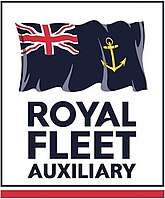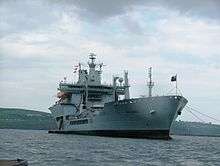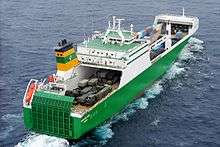Royal Fleet Auxiliary
| Royal Fleet Auxiliary | |
|---|---|
 | |
| Active | 1905 |
| Country | United Kingdom |
| Type | Auxiliary force |
| Role | Replenishment & Operational Support |
| Size | 1,850 personnel |
| RFA Headquarters | Leach Building, Whale Island, Portsmouth, England, UK |
| Colours | Blue and gold |
| Fleet |
2 Fast Fleet Tankers 1 Multi-role replenishment ship 2 Solid Replenishment Ships 3 Landing Ship Auxiliary's 1 Aviation Training Ship |
| Decorations | Queen's Colour |
| Website | Royal Fleet Auxiliary |
| Commanders | |
| Commodore in Chief | HRH The Earl of Wessex |
| Commodore RFA | Cdre Duncan Lamb |
The Royal Fleet Auxiliary (RFA) is a civilian-manned fleet owned by the United Kingdom's Ministry of Defence, whose purpose is to support the Royal Navy.[1] The RFA enables ships of the Royal Navy to maintain operations around the world. Its primary role is to supply the Royal Navy with fuel, ammunition and supplies, normally by replenishment at sea (RAS). It also transports Army and Royal Marine personnel, as well as supporting training exercises, and engaging in anti-piracy and anti-drug smuggling operations.
The RFA counts an Aviation Training ship/Hospital Ship and landing vessels amongst its assets. RFA personnel are members of the Ministry of Defence civil service, and since 2003, special members of the Royal Naval Reserve deemed sponsored reserves, which are civilians who must be part of the Armed Forces in some capacity, in order to carry out specialist civilian jobs in a military capacity. However the RFA itself is not part of the Naval Service, and officers wear Merchant Navy rank insignia with naval uniforms but are under naval discipline when the vessel is engaged on warlike operations. RFA vessels are commanded and crewed by these civilians, augmented with regular and reserve Royal Navy personnel to perform specialised military functions such as operating and maintaining helicopters or providing hospital facilities. Royal Navy personnel are also needed to operate certain weapons, such as the Phalanx, however other weapons (such as the GMPG or 20mm cannon) are operated by RFA personnel.
History
_refueling_USS_Donald_Cook_(DDG_75).jpg)
The RFA was first established in 1905 to provide coaling ships for the Navy in an era when the change from sail to coal-fired steam engines as the main means of propulsion meant that a network of bases around the world with coaling facilities or a fleet of ships able to supply coal were necessary for a fleet to operate away from its home country. Since the Royal Navy of that era possessed the largest network of bases around the world of any fleet, the RFA at first took a relatively minor role.
The RFA firstly became heavily relied on by the Royal Navy during World War II, when the British fleet was often far from available bases, either due to the enemy capturing such bases, or, in the Pacific, because of the sheer distances involved. World War II also saw naval ships staying at sea for much longer periods than had been the case since the days of sail. Techniques of Replenishment at Sea (RAS) were developed. The auxiliary fleet comprised a diverse collection, with not only RFA ships, but also commissioned warships and merchantmen as well. The need for the fleet to be maintained was unambiguously demonstrated by World War II.
After 1945, the RFA became the Royal Navy's main source of support in the many conflicts that the Navy was involved in. The RFA performed important service to the Far East Fleet off Korea from 1950 until 1953, when sustained carrier operations were again mounted in Pacific waters. During the extended operations of the Konfrontasi in the 1960s, the RFA was also heavily involved. As the network of British bases overseas shrank during the end of the Empire, the Navy increasingly relied on the RFA to supply its ships during routine deployments.
The civilian crews were recruited locally and included Chinese, Indian, Maltese, Sri Lankan, Seychelloise and West Indian seamen. Ships were frequently composed of a single nationality to avoid problems of diet or religion. Round Table class ships were exclusively manned by Hong Kong Chinese sailors from their initial introduction in 1963 until 1989 when Sir Lancelot was the last RFA to be crewed in this way.[2]
The RFA played an important role in the largest naval war since 1945, the Falklands War in 1982 (where one vessel was lost and another badly damaged), and also the Gulf War, Kosovo War, Afghanistan Campaign and the 2003 invasion of Iraq.
In July 2008, the RFA was presented with a Queen's Colour, an honour unique to a civilian organisation.[3][4][5]
Fleet
|
|
| Ships of the Royal Fleet Auxiliary |
|
A -
B -
C -
D -
E -
F -
G |
| Amphibious warfare ships |
| Replenishment ships |
| Miscellaneous ships |
Ships in RFA service carry the ship prefix RFA, standing for Royal Fleet Auxiliary, and fly the Blue Ensign defaced with an upright gold killick anchor. All Royal Fleet Auxiliaries are built and maintained to Lloyd's Register and Department for Transport standards.
The most important role provided by the RFA is replenishment at sea (RAS), therefore the mainstay of the current RFA fleet are the replenishment ships.[6] The Wave-class are 'Fleet Tankers', which primarily provide under way refuelling to Royal Navy ships, but can also provide a limited amount of dry cargo. The Rover-class that were decommissioned in 2017 will be replaced by the new Tide-class 'Fast Fleet Tankers' that were ordered in February 2012. The four new tankers have been ordered from DSME, South Korea with design support from Britain's BMT Defence Services, the first of which Tidespring will be entering service in 2017.[7] The 2015 Strategic Defence and Security Review has confirmed that three "Fleet Solid Support" Ships will be built and bidding for the contract will start in late 2016.[8]
Fort Victoria is a 'one-stop' replenishment ship, capable of providing under way refuelling and dry cargoes (I.e rearming, victualling and spares). The older Fort Rosalie-class ships provide only dry cargoes. The Wave-class, Fort Victoria and the Fort Rosalie-class have generous aviation facilities, providing aviation support and training facilities and significant vertical replenishment capabilities. They are capable of operating and supporting several Merlin and Lynx Wildcat helicopters, both of which are significant weapons platforms. The presence of aviation facilities on RFA ships allows for them to be used as 'force multipliers' for the task groups they support in line with Royal Navy doctrine.
The RFA is tasked with the role of supporting Royal Navy amphibious operations through its three Bay-class dock landing ships (LSD). Typically one Bay-class is also assigned as a permanent 'mothership' for Royal Navy mine countermeasures vessels in the Persian Gulf.
The unique support ship in the fleet is the aviation training ship Argus, a converted roll-on/roll-off (RoRo) container ship. She is tasked with peacetime aviation training and support. On active operations, she becomes the Primary Casualty Receiving Ship (PCRS); essentially a hospital ship. She cannot be described as such - and is not afforded such protection under the Geneva Convention - as she is armed. She can, however, venture into waters too dangerous for a normal hospital ship. Argus completed a refit in May 2007 intended to extend her operational life to 2020.[9]
The Point-class sealift ships were acquired in 2002 under a £1.25bn private finance initiative with Foreland Shipping known as the 'Strategic Sealift Service'. These ships are Merchant Navy vessels leased to the Ministry of Defence as and when needed. Originally six ships were part of the deal, allowing the MoD use of four of the ships with two being made available for commercial charter, these latter two were released from the contract in 2012.[10] The Ministry of Defence also maintains a single commercial tanker under permanent charter, the Maersk Rapier.[11] The ship is tasked with supplying fuel to the United Kingdoms various naval establishments at home and overseas, as well as providing aviation fuel to RAF stations at Cyprus, Ascension and the Falklands.[11] The MoD charters the vessel to commercial companies during periods where she is not in use for defence purposes.[11][12]
As of 2017, there are 9 ships in service with the Royal Fleet Auxiliary with a total displacement of approximately 240,000 tonnes. These figures exclude the five merchant navy vessels under charter to the Ministry of Defence.
Replenishment
| Class | Ship | Pennant No. | Entered service | Displacement | Type | Note |
|---|---|---|---|---|---|---|
| Wave-class | RFA Wave Knight | A389 | 2003 | 31,500 tonnes | Fast fleet tanker | [13] |
| RFA Wave Ruler | A390 | 2003 | 31,500 tonnes | Fast fleet tanker | [14] | |
| Fort Victoria-class | RFA Fort Victoria | A387 | 1994 | 33,675 tonnes | Multi-role replenishment ship | [15] |
| Fort Rosalie-class | RFA Fort Rosalie | A385 | 1978 | 23,384 tonnes | Solid replenishment ship | [16] |
| RFA Fort Austin | A386 | 1979 | 23,384 tonnes | Solid replenishment ship | [17] | |
 Wave Knight (Wave-class)
Wave Knight (Wave-class) Fort Victoria (Fort Victoria-class)
Fort Victoria (Fort Victoria-class).jpg) Fort Austin (Fort Rosalie-class)
Fort Austin (Fort Rosalie-class)
Amphibious warfare
| Class | Ship | Pennant No. | Entered service | Displacement | Type | Note |
|---|---|---|---|---|---|---|
| Bay-class | RFA Lyme Bay | L3007 | 2007 | 16,160 tonnes | Dock landing ship auxiliary | [18] |
| RFA Mounts Bay | L3008 | 2006 | 16,160 tonnes | Dock landing ship auxiliary | [19] | |
| RFA Cardigan Bay | L3009 | 2006 | 16,160 tonnes | Dock landing ship auxiliary | [20] | |
_maneuvers_into_position_to_receive_a_U.S._Navy_MH-60S_Knighthawk_helicopter_assigned_to_Helicopter_Sea_Combat_Squadron_(HSC)_26_in_130520-N-OA702-044.jpg) Cardigan Bay (Bay-class)
Cardigan Bay (Bay-class)
Miscellaneous
| Class | Ship | Pennant No. | Entered service | Displacement | Type | Note |
|---|---|---|---|---|---|---|
| — | RFA Argus | A135 | 1988 | 28,081 tonnes | Aviation training & hospital ship | [21] |
 Argus
Argus
Ministry of Defence
| Owner | Ship | Class | Entered service | Displacement | Type | Note |
|---|---|---|---|---|---|---|
| Foreland Shipping | MV Hurst Point | Point-class | 2002 | 23,000 tonnes | Ro-ro sealift | [22] |
| MV Eddystone | Point-class | 2002 | 23,000 tonnes | Ro-ro sealift | [22] | |
| MV Hartland Point | Point-class | 2002 | 23,000 tonnes | Ro-ro sealift | [22] | |
| MV Anvil Point | Point-class | 2003 | 23,000 tonnes | Ro-ro sealift | [22] | |
| A.P. Moller–Maersk Group | MV Maersk Rapier | — | 2003 | 35,000 DWT | Tanker | [11] |
 Hartland Point (Point-class)
Hartland Point (Point-class)- Maersk Rapier
Rank insignia
Officers
 Commodore
Commodore Commodore (Engineer)
Commodore (Engineer) Captain
Captain Chief Officer
Chief Officer First Officer
First Officer Second Officer (Communications)
Second Officer (Communications) Third Officer (Communications)
Third Officer (Communications)
- Department colours
With the exception of the executive (deck) department, RFA officer rank slides use a colour identification system for the different departments on ship.
| Logistics and Supply | Marine Engineering | Systems Engineering | Communications |
|---|---|---|---|
Rates
 Chief Petty Officer (Communications)
Chief Petty Officer (Communications) Petty Officer (Deck)
Petty Officer (Deck) Petty Officer (Communications)
Petty Officer (Communications) Leading Hand (Communications)
Leading Hand (Communications) Seaman Grade 1
Seaman Grade 1 Seaman Grade 2
Seaman Grade 2 Apprentice
Apprentice
See also
- Lists of ships operated by or in support of Her Majesty's Naval Service
- List of active Royal Navy ships
- List of active Royal Marines military watercraft
- List of ships of Serco Marine Services
- Related articles
- List of Royal Fleet Auxiliary ship names
- Merchant Navy (United Kingdom)
- Royal Research Ship
- Military Sealift Command - the United States Navy's analogue to the Royal Fleet Auxiliary
- Solid Support Ship
References
- ↑ Royal Fleet Auxiliary, royalnavy.mod.uk. Retrieved 10 October 2014.
- ↑ Puddefoot, Geoff (2010). Ready For Anything: The Royal Fleet Auxiliary 1905-1950 pp. 69-70. Seaforth Publishing. ISBN 978-1-848-32074-1.
- ↑ Journal of the Flag Institute, Issue 128, p. 20
- ↑ Gunline, April 2008, p. 7
- ↑ Gunline, Sept 2008, p. 1
- ↑ Britain's Modern Royal Navy, Paul Beaver, Patrick Stephens Limited, 1996, ISBN 1-85260-442-5
- ↑ "UK accepts RFA Tidespring after ten-month delay". NavalToday. Retrieved 27 January 2017.
- ↑ "2015 SDSR" (PDF).
- ↑ BBC News: Refit of navy ship RFA Argus ends, bbc.co.uk
- ↑ Strategic Sealift Service, publications.parliament.uk, 2 Sep 2013
- 1 2 3 4 Bush, Steve (2014). British Warships and Auxiliaries. Maritime Books. p. 50. ISBN 1904459552.
- ↑ Hired Tankers Hansard Written Answers - House of Commons, publications.parliament.uk, 27 October 2003
- ↑ "RFA Wave Knight (official webpage)". royalnavy.mod.uk. Royal Navy. Retrieved 23 April 2015.
- ↑ "RFA Wave Ruler (official webpage)". royalnavy.mod.uk. Royal Navy. Retrieved 23 April 2015.
- ↑ "RFA Fort Victoria (official webpage)". royalnavy.mod.uk. Royal Navy. Retrieved 23 April 2015.
- ↑ "RFA Fort Rosalie (official webpage)". royalnavy.mod.uk. Royal Navy. Retrieved 23 April 2015.
- ↑ "RFA Fort Austin (official webpage)". royalnavy.mod.uk. Royal Navy. Retrieved 23 April 2015.
- ↑ "RFA Lyme Bay (official webpage)". royalnavy.mod.uk. Royal Navy. Retrieved 23 April 2015.
- ↑ "RFA Mounts Bay (official webpage)". royalnavy.mod.uk. Royal Navy. Retrieved 23 April 2015.
- ↑ "RFA Cardigan Bay (official webpage)". royalnavy.mod.uk. Royal Navy. Retrieved 23 April 2015.
- ↑ "RFA Argus (official webpage)". royalnavy.mod.uk. Royal Navy. Retrieved 23 April 2015.
- 1 2 3 4 The Royal Navy Handbook, 2003, Ministry of Defence, page 104
Bibliography
The Royal Fleet Auxiliary - A Century of Service. Adams/Smith. London 2005. Chatham Publishing. ISBN 1-86176-259-3.
External links
- Royal Navy - Our Organisation - Royal Fleet Auxiliary (royalnavy.mod.uk)
- RFA Association Photo Archive (rfaaplymouth.org)
- The Marine Society provides a crew library service and education services to serving Merchant Navy and Royal Navy personnel.
- History of the RFA (historicalrfa.org)

